Founded 1607 Date dissolved July 4, 1776 | 1760–1783 George III (last) Population 2.4 million (1775) | |
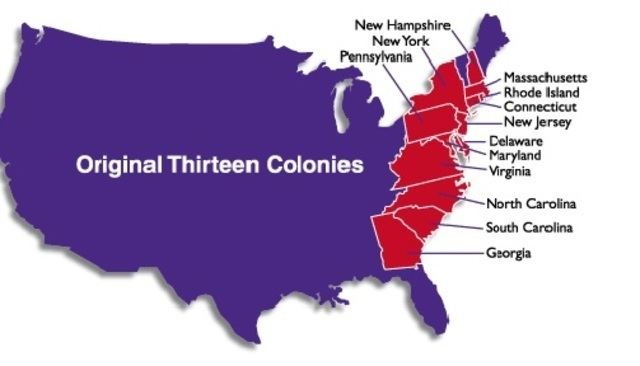 | ||
Religion Puritanism, Anglicanism, other Protestantism, Judaism, Roman Catholicism, Native American religion Government Similar Southern Colonies, Middle Colonies, New England Colonies | ||
Thirteen colonies the new england colonies
The Thirteen Colonies were a group of British colonies on the East coast of North America founded in the 17th and 18th centuries that declared independence in 1776 and formed the United States. The thirteen were (roughly north to south): New Hampshire, Massachusetts Bay, Connecticut, Rhode Island and Providence Plantations, New York, New Jersey, Pennsylvania, Delaware, Maryland, Virginia, North Carolina, South Carolina, and Georgia.
Contents
- Thirteen colonies the new england colonies
- Thirteen colonies the middle colonies
- The Thirteen Colonies
- Other colonies
- Predecessors prior to 1730
- Population
- Slaves
- Religion and education
- British role
- Self government
- Economic policy
- Legislation prior to 1763
- Coming of the American revolution
- Other British colonies
- Historiography
- References
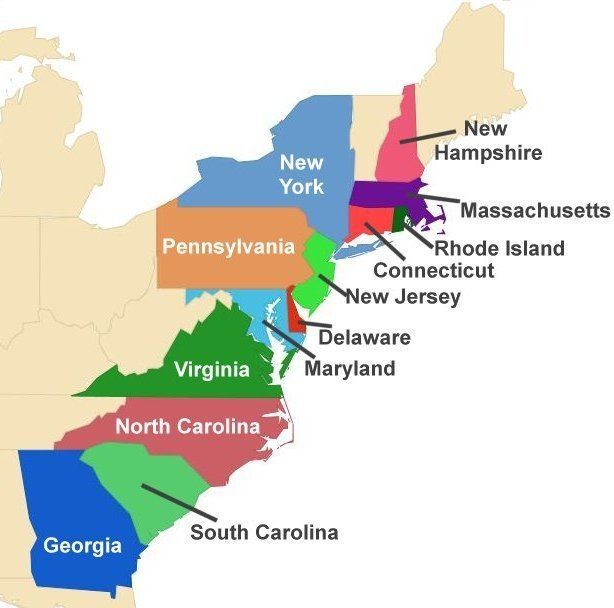
The Thirteen Colonies had very similar political, constitutional, and legal systems, and were dominated by Protestant English-speakers. They were part of Britain's possessions in the New World, which also included colonies in present-day Canada and the Caribbean, as well as East and West Florida. In the 18th century, the British government operated its colonies under a policy of mercantilism, in which the central government administered its possessions for the economic benefit of the mother country. However, the Thirteen Colonies had a high degree of self-government and active local elections, and increasingly resisted London's demands for more control. In the 1750s, the colonies began collaborating with each other instead of dealing directly with Britain. These inter-colonial activities cultivated a sense of shared American identity and led to calls for protection of the colonists' "Rights as Englishmen", especially the principle of "no taxation without representation". Grievances with the British government led to the American Revolution, in which the colonies collaborated in forming a Continental Congress, which declared independence in 1776 and became a national government.
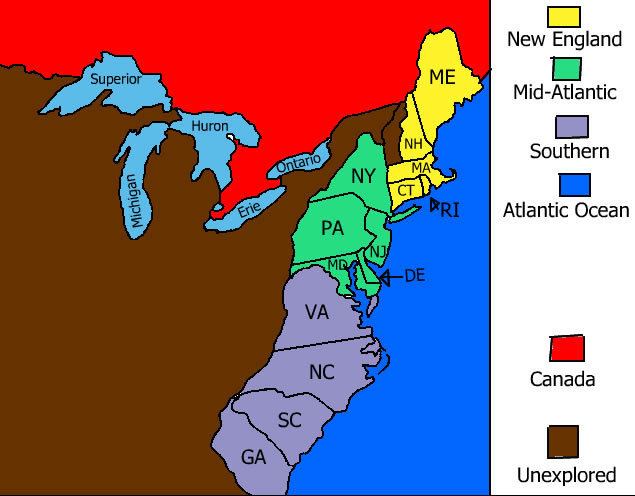
Thirteen colonies the middle colonies
The Thirteen Colonies
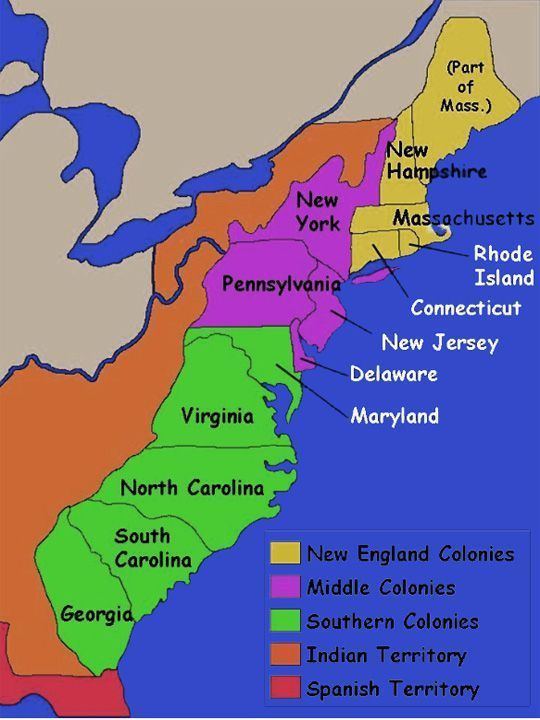
Each of the thirteen colonies developed its own system of limited local self-government under an appointed royal governor, derived from the English system of common law and composed largely of independent farmers who owned their own land, voted for their local and provincial government, and served on local juries. Colonial decisions were subject to approval by the governor and the home government. There were also substantial populations of African slaves in some of the colonies, especially Virginia, the Carolinas, and Georgia.
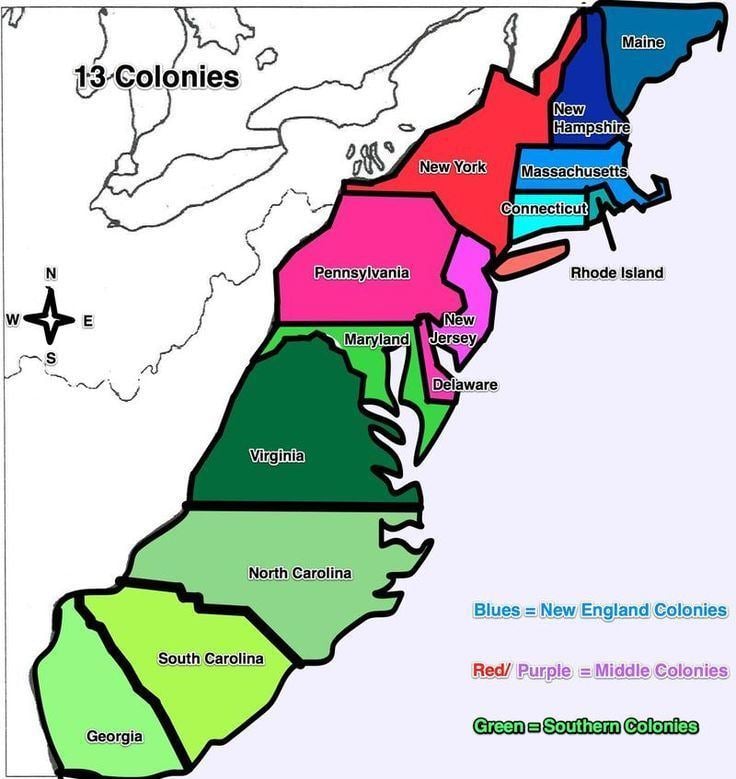
The names of the colonies were chosen by the founders and proprietors, subject to royal approval, and given in the founding charters. Nine of the thirteen chose to include in their names the term "Province of...", which had no political significance. Later residents tended to drop the ambiguous terminology, as in the map shown in the article Province of New Jersey, which is labeled simply "East Jersey" and "West Jersey".
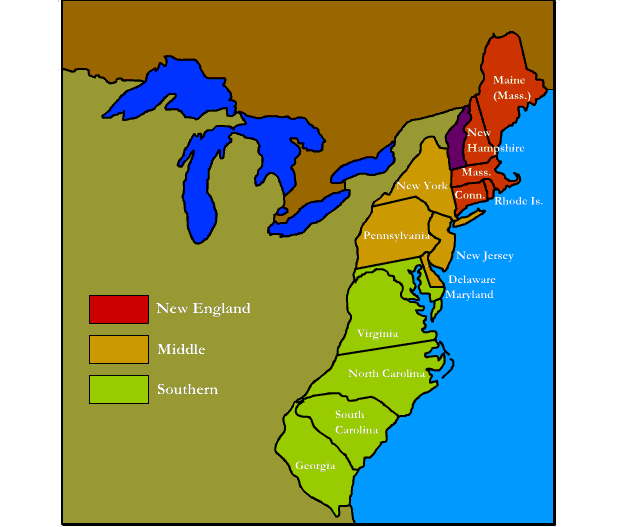
Following a series of protests over taxes in the 1760s and 1770s, these thirteen colonies united politically and militarily in opposition to the British government and fought the American Revolutionary War (1775–1783). In July 1776, they formed a new nation called the "United States of America" and declared independence. The new nation achieved that goal by winning the American Revolutionary War with the aid of France, the Netherlands, and Spain. The American flag features thirteen horizontal stripes which represent these original thirteen colonies.
Other colonies
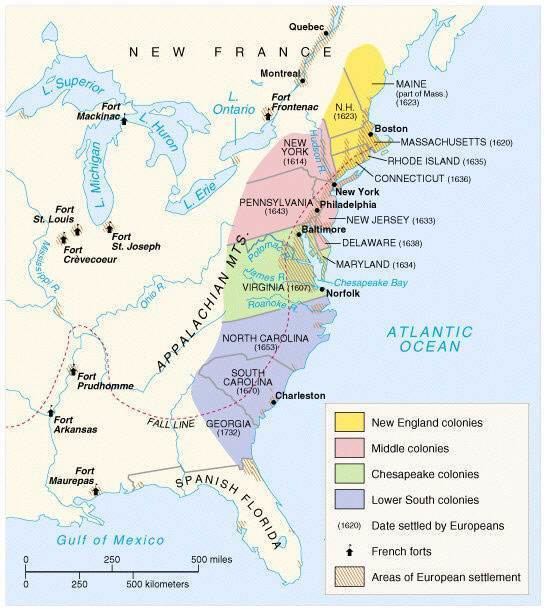
Besides these thirteen colonies, Britain had another dozen in the New World. Those in the British West Indies, Newfoundland, the Province of Quebec, Nova Scotia, Prince Edward Island, Bermuda, and East and West Florida remained loyal to the crown throughout the war (although Spain reacquired Florida before the war was over). There was a certain degree of sympathy with the Patriot cause in several of the other colonies, but their geographical isolation and the dominance of British naval power precluded any effective participation. The British crown had only recently acquired those lands, and many of the issues facing the Thirteen Colonies did not apply to them, especially in the case of Quebec and Florida.
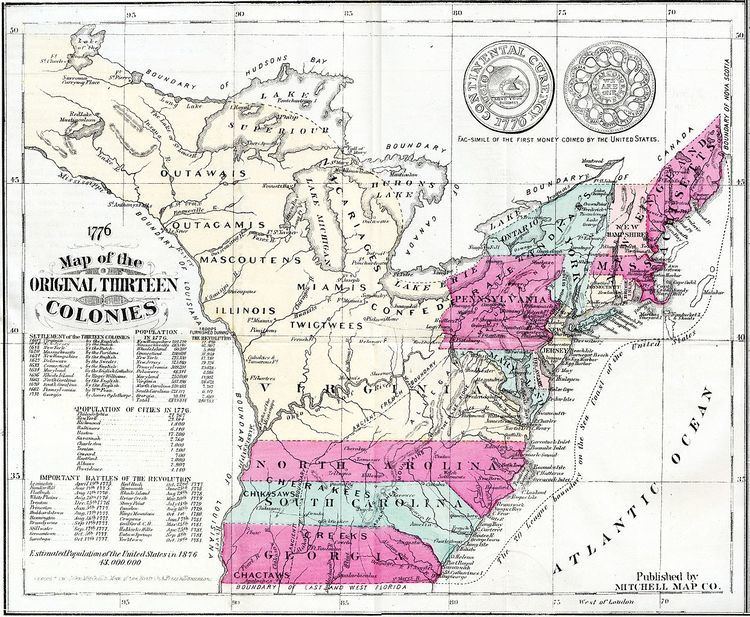
Contemporary documents usually list the thirteen colonies of British North America in geographical order, from the north to the south.
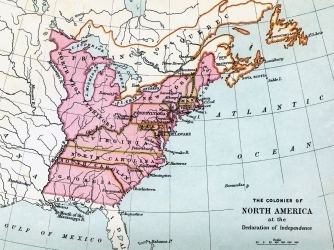
Predecessors prior to 1730
Population
Edwin Perkins notes the importance of good health and colonies: "Fewer deaths among the young meant that a higher proportion of the population reached reproductive age, and that fact alone helps to explain why the colonies grew so rapidly." There were, of course, many other reasons for the population growth besides good health, such as the Great Migration.
Note: the population figures are estimates by historians; they do not include the native tribes outside the jurisdiction of the colonies. They do include natives living under colonial control, as well as slaves and indentured servants.
By 1776, about 85% of the white population was of English, Irish, Scottish, or Welsh descent, with 9% of German origin and 4% Dutch. These populations continued to grow at a rapid rate throughout the 18th century, primarily because of high birth rates and relatively low death rates. Immigration was a minor factor from 1774 to 1830. Over 90% were farmers, with several small cities that were also seaports linking the colonial economy to the larger British Empire.
Slaves
Slavery was legal and practiced in many of the Thirteen Colonies. In most places, it involved house servants or farm workers. It was of economic importance in the export-oriented tobacco plantations of Virginia and Maryland, and the rice and indigo plantations of South Carolina. About 287,000 slaves were imported into the Thirteen Colonies over a period of 160 years, or 2% of the 12 million slaves taken from Africa. The great majority went to sugar colonies in the Caribbean and to Brazil, where life expectancy was short and the numbers had to be continually replenished. By the mid-18th century, life expectancy was much higher in the American colonies.
Combined with a very high birth rate, the numbers grew rapidly by excesses of births over deaths, reaching nearly 4 million by the 1860 census. From 1770 until 1860, the rate of natural growth of North American slaves was much greater than for the population of any nation in Europe, and was nearly twice as rapid as that of England.
Religion and education
The colonies were religiously diverse, with numerous Protestant denominations brought by British, German, Dutch, and other immigrants. Religious faith was strong in New England and many German and Dutch settlements. However, before the First Great Awakening of the 1740s most colonists were religiously inactive. Many intellectuals after 1750 were deist. The Anglican Church of England was officially established in most of the South, but its churches were controlled by local planters and its enemies blocked the appointment of bishops. The Reformed tradition was supported by Puritans in New England, who felt that the Church of England was not sufficiently reformed. The Continental Reformed church was also popular among Dutch Americans. Lutheranism was prevalent among German immigrants. Education was widespread in the northern colonies, which had established colleges led by Harvard College, College of New Jersey (Princeton), and Yale College, as well as the College of Rhode Island (Brown), King's College (Columbia), the College of Philadelphia (University of Pennsylvania), and Dartmouth; meanwhile, the College of William and Mary trained the elite in Virginia. Public schooling was rare outside New England.
British role
The Royal government in London took an increasing interest in the affairs of the colonies after 1680, which were growing rapidly in population and wealth. In 1680, only Virginia was a royal colony; by 1720, half were under the control of royal governors. These governors were appointees closely tied to the government in London.
Historians before the 1880s emphasized American nationalism. However, intellectual leadership after that was held by the "Imperial school" led by Herbert L. Osgood, George Louis Beer, Charles McLean Andrews, and Lawrence H. Gipson. They dominated colonial historiography into the 1940s. They emphasized and often praised the attention that London gave to all the colonies. There was never a threat (before the 1770s) that any colony would revolt or seek independence.
Self-government
British settlers did not come to the American colonies with the intention of creating a democratic system, yet by doing so without a land-owning aristocracy they created a broad electorate and a pattern of free and frequent elections that put a premium on voter participation. The colonies offered a much broader franchise than England or indeed any other country. Any property-owner could vote for members of the lower house of the legislature, and in Connecticut and Rhode Island they could even vote for the governor. Legitimacy for a voter meant having an "interest" in society; as the South Carolina legislature said in 1716, "it is necessary and reasonable, that none but such persons will have an interest in the Province should be capable to elect members of the Commons House of Assembly." Women, children, indentured servants, and slaves were subsumed under the interest of the family head. The main legal criterion for having an "interest" was ownership of property, which was uncommon in Britain, where nineteen out of twenty men were controlled politically by their landlords. London insisted on it for the colonies, telling governors to exclude from the ballot men who were not freeholders—that is, those who did not own land. Nevertheless, land was so widely owned that 50% to 80% of the men were eligible to vote.
The colonial political culture emphasized deference, so that local notables were the men who ran and were chosen. But sometimes they competed with each other, and had to appeal to the common man for votes. There were no political parties, and would-be legislators formed ad-hoc coalitions of their families, friends, and neighbors. Outside Puritan New England, election day brought in all the men from the countryside to the county seat to make merry, politick, shake hands with the grandees, meet old friends, and hear the speeches—and all the while toasting, eating, treating, tippling, and gambling. They voted by shouting their choice to the clerk, as supporters cheered or booed. Candidate George Washington spent £39 for treats for his supporters. The candidates knew that they had to "swill the planters with bumbo (rum)." Elections were carnivals where all men were equal for one day and traditional restraints relaxed.
The actual rate of voting ranged from 20% to 40% of all adult white males. The rates were higher in Pennsylvania and New York, where long-standing factions mobilized supporters at a higher rate, based on ethnic and religious groups. New York and Rhode Island developed long-lasting two-faction systems that held together for years at the colony level, but did not reach into local affairs. The factions were based on the personalities of a few leaders and an array of family connections, and had little basis in policy or ideology. Elsewhere the political scene was in a constant whirl, and based on personality rather than long-lived factions or serious disputes on issues.
The colonies were independent of each other before 1774, as efforts had failed to form a colonial union through the Albany Congress of 1754, led by Benjamin Franklin. The thirteen all had well established systems of self-government and elections based on the Rights of Englishmen, which they were determined to protect from imperial interference. The vast majority of men were eligible to vote.
Economic policy
The British Empire at the time operated under the mercantile system, where all trade was concentrated inside the Empire, and trade with other empires was forbidden. The goal was to enrich Britain—its merchants and its government. Whether the policy was good for the colonists was not an issue in London, but Americans became increasingly restive with mercantilist policies.
Mercantilism meant that the government and the merchants became partners with the goal of increasing political power and private wealth, to the exclusion of other empires. The government protected its merchants—and kept others out—by trade barriers, regulations, and subsidies to domestic industries in order to maximize exports from and minimize imports to the realm. The government had to fight smuggling—which became a favorite American technique in the 18th century to circumvent the restrictions on trading with the French, Spanish or Dutch. The tactic used by mercantilism was to run trade surpluses, so that gold and silver would pour into London. The government took its share through duties and taxes, with the remainder going to merchants in Britain. The government spent much of its revenue on a superb Royal Navy, which not only protected the British colonies but threatened the colonies of the other empires, and sometimes seized them. Thus the British Navy captured New Amsterdam (New York) in 1664. The colonies were captive markets for British industry, and the goal was to enrich the mother country.
Legislation prior to 1763
Britain implemented mercantilism by trying to block American trade with the French, Spanish, or Dutch empires using the Navigation Acts, which Americans avoided as often as they could. The royal officials responded to smuggling with open-ended search warrants (Writs of Assistance). In 1761, Boston lawyer James Otis argued that the writs violated the constitutional rights of the colonists. He lost the case, but John Adams later wrote, "Then and there the child Independence was born."
However, the colonists took pains to argue that they did not oppose British regulation of their external trade; they only opposed legislation which affected them internally.
On December 1, 1763, Patrick Henry argued the Parson's Cause in the Colony of Virginia at Hanover Courthouse, where the legislature had passed a law which was then vetoed by the king. Henry argued "that a King, by disallowing Acts of this salutary nature, from being the father of his people, degenerated into a Tyrant and forfeits all right to his subjects' obedience".
Great Britain took control of the French holdings in North America outside the Caribbean following their victory in the French and Indian War in 1763. The British sought to maintain peaceful relations with those Indian tribes that had allied with the French, to keep them separated from the American frontiersmen. To this end, the Royal Proclamation of 1763 restricted settlement west of the Appalachian Mountains, as this was designated an Indian Reserve. Some groups of settlers disregarded the proclamation, continuing to move west and establish farms. The proclamation was soon modified and was no longer a hindrance to settlement, but the fact angered the colonists that it had been promulgated without their prior consultation.
Coming of the American revolution
Americans insisted on the principle of "no taxation without representation" beginning with the intense protests over the Stamp Act of 1765, representation being understood in the context of Parliament directly levying the duty or excise tax, and thus by-passing the colonial legislatures, which had levied taxes on the colonies in the monarch's stead prior to 1763. They argued that the colonies had no representation in the British Parliament, so it was a violation of their rights as Englishmen for taxes to be imposed upon them. The other British colonies that had assemblies largely agreed with those in the Thirteen Colonies, but they were thoroughly controlled by the British Empire and the Royal Navy, so protests were hopeless.
Parliament rejected the colonial protests and asserted its authority by passing new taxes. Trouble escalated over the tea tax, as Americans in each colony boycotted the tea, and those in Boston dumped the tea in the harbor during the Boston Tea Party in 1773. Tensions escalated in 1774 as Parliament passed the laws known as the Intolerable Acts, which greatly restricted self-government in the colony of Massachusetts, among other things.
In response, the colonies formed extralegal bodies of elected representatives, generally known as Provincial Congresses. Colonists emphasized their determination by boycotting imports of British merchandise. Later in 1774, twelve colonies sent representatives to the First Continental Congress in Philadelphia. During the Second Continental Congress, the thirteenth colony (Georgia) sent delegates, as well. By spring 1775, all royal officials had been expelled from all thirteen colonies. The Continental Congress was the national government. It raised an army to fight the British and named George Washington its commander, made treaties, declared independence, and recommended that the colonies write constitutions and become states.
Other British colonies
At the time of the war Britain had seven other colonies on the Atlantic coast of North America: Newfoundland, Rupert's Land (the area around the Hudson Bay), Nova Scotia, Prince Edward Island, East Florida, West Florida, and the Province of Quebec. There were other colonies in the Americas as well, largely in the British West Indies. These colonies remained loyal to the crown.
Newfoundland stayed loyal to Britain without question. It was exempt from the Navigation Acts and shared none of the grievances of the continental colonies. It was tightly bound to Britain and controlled by the Royal Navy and had no assembly that could voice grievances.
Nova Scotia had a large Yankee element that had recently arrived from New England, and shared the sentiments of the Americans about demanding the rights of the British men. The royal government in Halifax reluctantly allowed the Yankees of Nova Scotia a kind of "neutrality." In any case, the island-like geography and the presence of the major British naval base at Halifax made the thought of armed resistance impossible.
Quebec was inhabited by French Catholic settlers who came under British control in the previous decade. The Quebec Act of 1774 gave them formal cultural autonomy within the empire, and many priests feared the intense Protestantism in New England. The American grievances over taxation had little relevance, and there was no assembly nor elections of any kind that could have mobilized any grievances. Even so, the Americans offered membership in the new nation and sent a military expedition that failed to capture Canada in 1775. Most Canadians remained neutral but some joined the American cause.
In the West Indies the elected assemblies of Jamaica, Grenada, and Barbados formally declared their sympathies for the American cause and called for mediation, but the others were quite loyal. Britain carefully avoided antagonizing the rich owners of sugar plantations (many of whom lived in London); in turn the planters' greater dependence on slavery made them recognize the need for British military protection from possible slave revolts. The possibilities for overt action were sharply limited by the overwhelming power of Royal Navy in the islands. During the war there was some opportunistic trading with American ships.
In Bermuda and the Bahamas local leaders were angry at the food shortages caused by British blockade of American ports. There was increasing sympathy for the American cause, including smuggling, and both colonies were considered "passive allies" of the United States throughout the war. When an American naval squadron arrived in the Bahamas to seize gunpowder, the colony gave no resistance at all.
East Florida and West Florida were territories transferred from Spain to Britain after the French and Indian War by treaty. The few British colonists there needed protection from attacks by Indians and Spanish privateers. After 1775, East Florida became a major base for the British war effort in the South, especially in the invasions of Georgia and South Carolina. However, Spain seized Pensacola in West Florida in 1781, then recovered both territories in the Treaty of Paris that ended the war in 1783. Spain ultimately transferred the Florida provinces to the United States in 1819.
Historiography
The first British empire centered on the 13 American colonies, which attracted large numbers of settlers from Britain. The "Imperial School" in the 1900s–1930s period took a favorable view of the benefits of empire, emphasizing its successful economic integration. The Imperial School included such historians as Herbert L. Osgood, George Louis Beer, Charles M. Andrews, and Lawrence Gipson.
The shock of Britain's defeat in 1783 caused a radical revision of their policies on colonialism, thereby producing what historians call the end of the First British Empire; of course, Britain still owned Canada and some islands in the West Indies. Ashley Jackson writes:
The first British Empire was largely destroyed by the loss of the American colonies, followed by a 'swing to the east' and the foundation of a second British Empire based on commercial and territorial expansion in South Asia.
Much of the historiography concerns the reasons why the Americans rebelled in the 1770s and successfully broke away. Since the 1960s, the mainstream of historiography emphasizes the growth of American consciousness and nationalism, and its Republican value system in opposition to the aristocratic viewpoint of British leaders.
In the analysis of the coming of the Revolution, historians in recent decades have mostly used one of three approaches.
